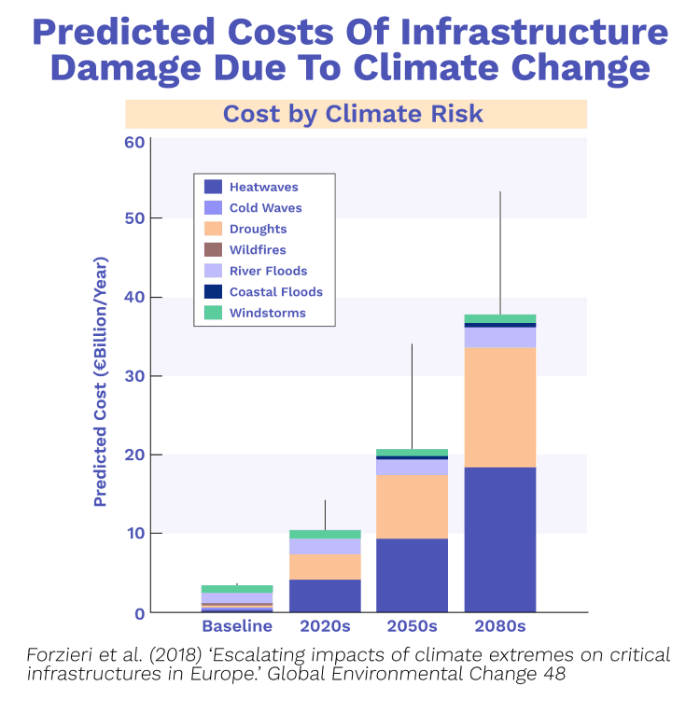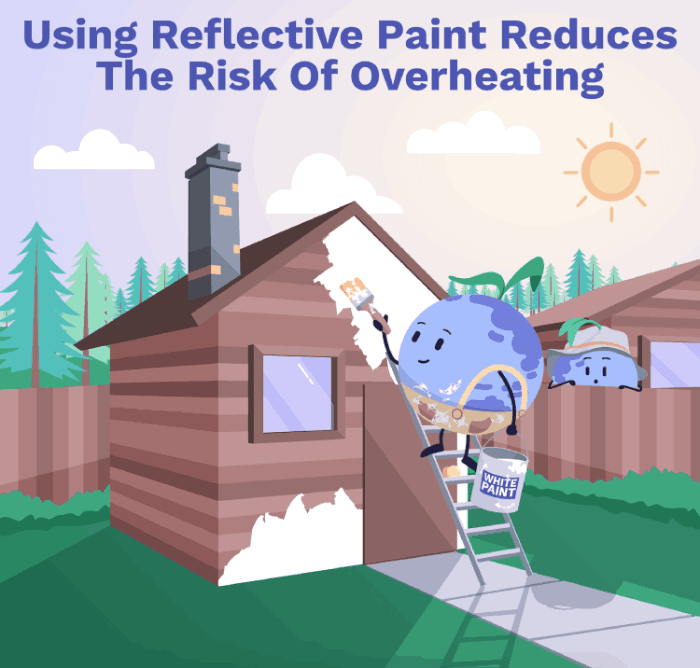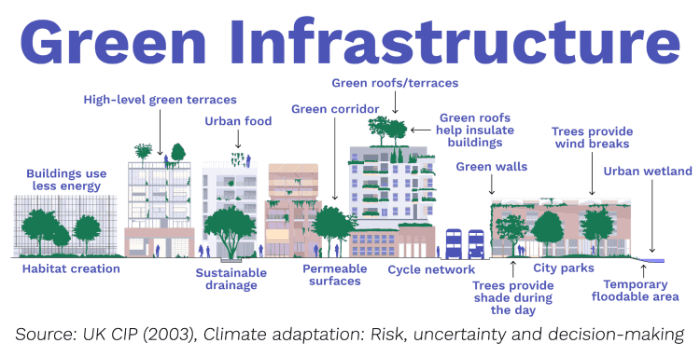For key infrastructure links, it can be worth building extra ‘redundant’ versions as a backup in the event of a natural disaster 
 . For example, if a major bridge was to collapse in a flood, a backup bridge would be there to save the day
. For example, if a major bridge was to collapse in a flood, a backup bridge would be there to save the day  . Crucially, we need to monitor existing structures to reduce their risk of failure over time
. Crucially, we need to monitor existing structures to reduce their risk of failure over time  . With accurate forecasting, we can reduce the risk of disaster by adapting early and avoid having to make difficult decisions further down the line
. With accurate forecasting, we can reduce the risk of disaster by adapting early and avoid having to make difficult decisions further down the line  . If we really want to level-up, we can build multipurpose infrastructure, such as traffic tunnels which double as a funnel for excess stormwater
. If we really want to level-up, we can build multipurpose infrastructure, such as traffic tunnels which double as a funnel for excess stormwater 
 .
.
To save time and money, another option is to upgrade the infrastructure we already have. This is called retrofitting  . Examples include permeable pavements, raised roads and water fountains in public spaces
. Examples include permeable pavements, raised roads and water fountains in public spaces  . In Abu Dhabi, architects have attached geometric shades to the outside of skyscrapers that not only provide shelter from the sun but are even able to change their position in response to sunlight
. In Abu Dhabi, architects have attached geometric shades to the outside of skyscrapers that not only provide shelter from the sun but are even able to change their position in response to sunlight  . Cool, right?
. Cool, right?
In fact, retrofitting can be as simple as installing heat sensors or painting our roofs, roads and railways white to reflect sunlight 
 . If done properly, a white roof can reflect up to 80% of the sun’s energy, compared to just 5-10% for a black roof
. If done properly, a white roof can reflect up to 80% of the sun’s energy, compared to just 5-10% for a black roof 
 . Think how effective this could be given that pavements and roofs typically make up over 60% of urban surfaces
. Think how effective this could be given that pavements and roofs typically make up over 60% of urban surfaces  .
.
Another simple retrofitting solution is air conditioning (or AC). Unfortunately, AC is a double-edged sword because it can actually make the urban heat problem worse in the long run 

 . This is because increased demand for air conditioning puts pressure on the energy grid : for every 1°C increase in temperature, electricity use in cities can increase by 2-4%
. This is because increased demand for air conditioning puts pressure on the energy grid : for every 1°C increase in temperature, electricity use in cities can increase by 2-4%  ! This generates more greenhouse gas emissions and increases temperatures
! This generates more greenhouse gas emissions and increases temperatures 
 .
.
A more sustainable option, as discussed earlier, is to design buildings that better tolerate a wider range of temperatures  . Alternatively, one particularly novel solution is to combine a renewable-powered cooling system with carbon capture technology (check out our other course on carbon capture!) for a real win-win
. Alternatively, one particularly novel solution is to combine a renewable-powered cooling system with carbon capture technology (check out our other course on carbon capture!) for a real win-win  .
.
1. Governance, Science & Policy
Adaptation will be a collaborative effort between governments, industry and local action  . Successful adaptation should also make the most of available scientific expertise. For example, Earth scientists can help us by developing basic floodplain and geological maps to help us identify the safest places to build
. Successful adaptation should also make the most of available scientific expertise. For example, Earth scientists can help us by developing basic floodplain and geological maps to help us identify the safest places to build  . In the energy sector, data scientists have identified areas prone to bushfires by using remote weather stations
. In the energy sector, data scientists have identified areas prone to bushfires by using remote weather stations  . By avoiding these high-risk areas, we can then decrease the likelihood of power cuts
. By avoiding these high-risk areas, we can then decrease the likelihood of power cuts  . This type of forward-thinking is really useful when redesigning urban areas and planning future infrastructure projects.
. This type of forward-thinking is really useful when redesigning urban areas and planning future infrastructure projects.
Within the construction industry, it is becoming increasingly important to find more efficient ways of dealing with waste and emissions and to establish stronger environmental regulations. For example, in France, new construction projects are encouraged to consider future climate risks early on  . Unfortunately, the majority of environmental codes are not quite so modern - only 5 out of 35 OECD countries have up-to-date codes that mention climate change
. Unfortunately, the majority of environmental codes are not quite so modern - only 5 out of 35 OECD countries have up-to-date codes that mention climate change  .
.
2. Economics
Estimates for the global cost of adapting infrastructure range between $8-130 billion by 2030  . That’s quite a lot of money, so how might we increase available funding?
. That’s quite a lot of money, so how might we increase available funding?
To do this, we need to look to different sources of funding, from public and private grants all the way up to government schemes and multilateral development banks 
 .
.
Given that 87-91% of funding for infrastructure comes from governments in low- and middle-income countries  , there is a strong case for rethinking how (and by whom) governments are funded and where that money is then invested
, there is a strong case for rethinking how (and by whom) governments are funded and where that money is then invested  . In Fiji, the government has introduced the Environment and Climate Adaptation Levy - a 10% tax on luxury items and rich households
. In Fiji, the government has introduced the Environment and Climate Adaptation Levy - a 10% tax on luxury items and rich households  . As of 2019, the levy has successfully generated over FJ$119 million (that’s roughly US$56 million), the majority of which has been spent adapting infrastructure including new bridges, seawalls and drainage systems
. As of 2019, the levy has successfully generated over FJ$119 million (that’s roughly US$56 million), the majority of which has been spent adapting infrastructure including new bridges, seawalls and drainage systems  .
.
Through involving local communities when planning climate change adaptation, we can benefit from local knowledge. This could include traditional techniques for predicting severe weather events 
 or restoring coastal habitats to protect both their inhabitants and the infrastructure on which they rely
or restoring coastal habitats to protect both their inhabitants and the infrastructure on which they rely 
 .
.
4. Green Infrastructure and Nature-based Solutions
We can also literally make our cities greener by creating more space for nature 
 . For example, green roofs moderate high summer temperatures
. For example, green roofs moderate high summer temperatures  and absorb excess stormwater
and absorb excess stormwater 
 , and can even support mini farms
, and can even support mini farms  .
.
These solutions are part of a larger idea called green infrastructure, as opposed to man-made ‘grey’ infrastructure 
 . Green infrastructure looks to make use of natural features, like ponds, parks and woodland, to both improve urban living
. Green infrastructure looks to make use of natural features, like ponds, parks and woodland, to both improve urban living 

 and help cities cope with climate change by soaking up excess stormwater and reducing local temperatures
and help cities cope with climate change by soaking up excess stormwater and reducing local temperatures 
 .
.
One study for example, found that investing $100 million per year in urban tree planting could potentially create enough shade to cut average temperatures by 1°C for 77 million people across the world  . However, for this to be truly sustainable we need to make sure we have adequate water supplies
. However, for this to be truly sustainable we need to make sure we have adequate water supplies  or use drought-tolerant
or use drought-tolerant  , and preferably native, tree species
, and preferably native, tree species 

 .
.
Nature can inspire architects too. This is called biomimicry  and can be used to design infrastructure that’s better adapted to its environment - from buildings inspired by desert beetles and termite mounds
and can be used to design infrastructure that’s better adapted to its environment - from buildings inspired by desert beetles and termite mounds  for natural ventilation and temperature regulation
for natural ventilation and temperature regulation  , to hydropower devices based on seaweed
, to hydropower devices based on seaweed  .
.
We can also adapt by taking inspiration from whole ecosystems. In China, urban planners have put one quarter of the country’s land under protection to boost access to freshwater and improve the land’s capacity to cope with natural disasters by allowing protected floodplains and waterways to hold surplus water 

 .
.
Conclusion
It is important to remember that different places will experience different climatic risks  . This means there is no simple roadmap for how to build climate-resilient cities
. This means there is no simple roadmap for how to build climate-resilient cities  . However, it is likely we will need a combination of both ‘green’ and ‘grey’ solutions in order to minimise locally relevant climate risks
. However, it is likely we will need a combination of both ‘green’ and ‘grey’ solutions in order to minimise locally relevant climate risks 

 .
.
Next Chapter. This covers everything from travel and communication to the distribution of basic resources like water and energy
. We can’t afford to lose these services so let’s explore how we might adapt them to a changing climate.
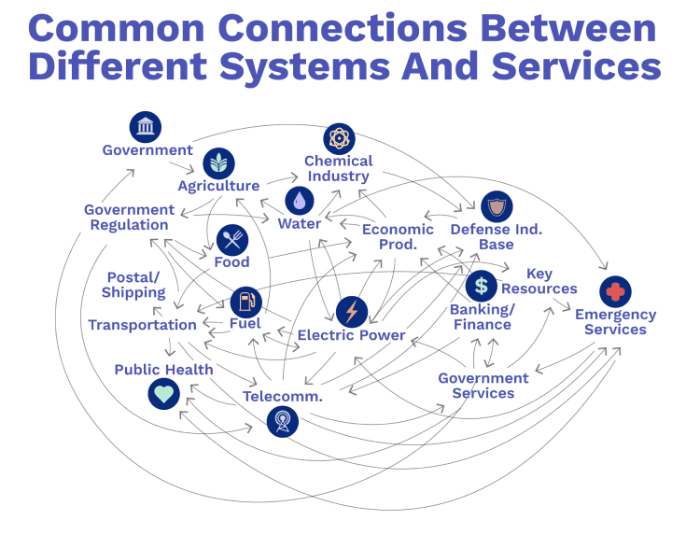
. However, this protection only goes so far - the majority of infrastructure today was only designed to withstand existing climate extremes and seasonal variation
. Moreover, infrastructure networks are closely interconnected; meaning any disruption in one system will have knock-on effects for others
. Rapid climate change therefore poses threats to the long-term sustainability of how we interact as a society
.
. Building materials respond to higher temperatures by expanding
. This builds up as internal stress and causes structures to deform and become unstable, leading to buckled railways and the formation of cracks and potholes in roads
.
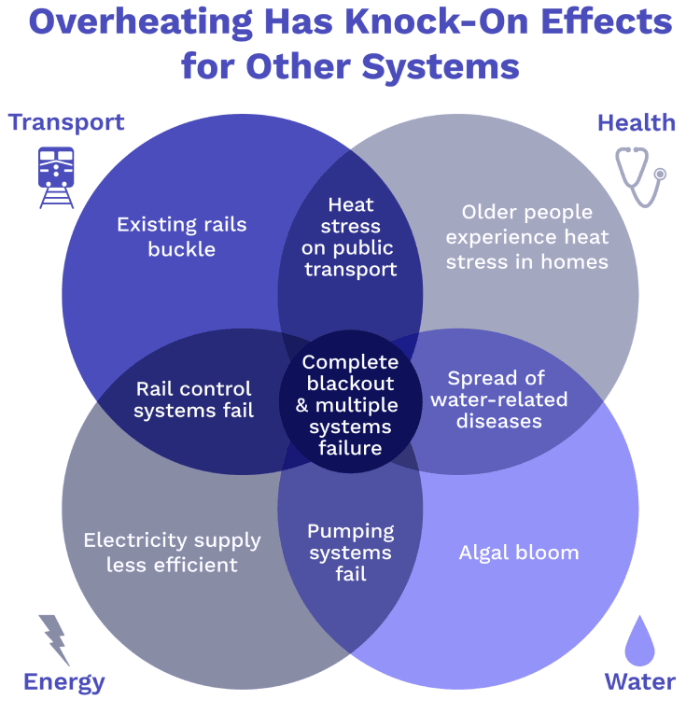
. Extreme floods, storms and hurricanes all have a devastating and lasting impact on transport, communications and water supply networks
. Globally, river and coastal flooding alone is predicted to cause increased structural damage worth trillions of dollars (US$)
.
and energy
will likely increase. Indirectly, demand for infrastructure will also shift as different populations move in response to climate change
.
